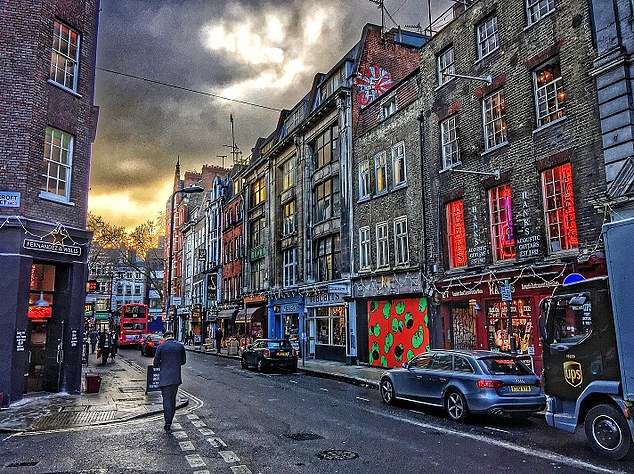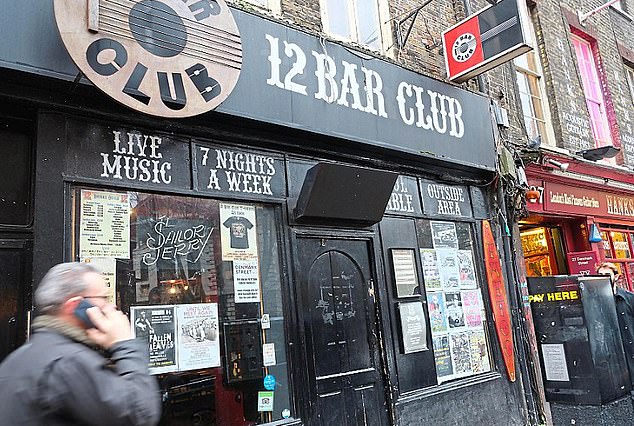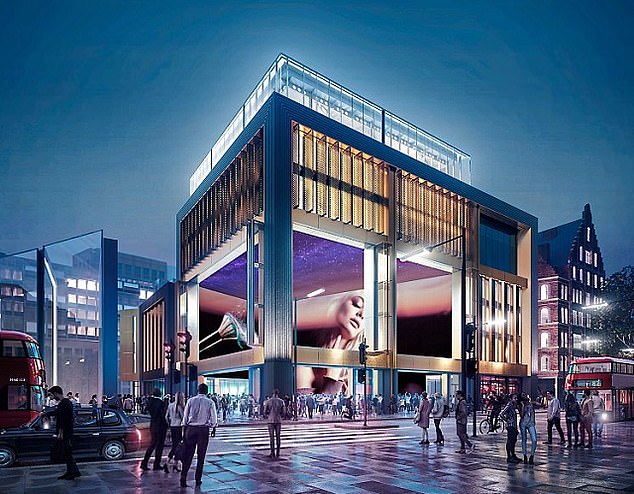The music never stops on London’s Tin Pan Alley: Outernet Global embarks on a £1bn revamp of historic Denmark St
Television viewers hooked on the latest series of Strike will have watched the fictional detective lurking at his haunts on Denmark Street, a small, colourful thoroughfare off London’s Charing Cross.
Cormoran Strike has his office and home above the 12 Bar Club, a legendary venue where artists including Jeff Buckley, The Libertines and the young Adele have performed.
In real life, the 12 Bar has been boarded up for five years. And Denmark Street, whose habitues have included Elton John, the Kinks and the Rolling Stones, is much-loved by music aficionados, though even its most ardent fan would have to admit it has seen better days.

Philip Bourchier O’Ferrall, chief exec of media company Outernet Global, has outlined plans to restore the London’s Denmark Street (pictured) known as the capitals’ Tin Pan Alley’
Under bold £1billion plans to restore the London’s Tin Pan Alley and its environs, Philip Bourchier O’Ferrall, the chief executive of media company Outernet Global, has vowed to bring back the 12 Bar Club. He is equally determined that Covid-19 will not get in the way of his grand vision.
‘There are not as many people out on the streets, but it is an amazing vibe in Soho, everyone is sitting on nicely spaced tables. It is less grubby and more organised,’ he says.
He expects his project to be up and running in the middle of next year and adds: ‘I have dealt with ebola, ash clouds, terrorism and epidemics. We have to get back to people going out again.’


Tuning in: Fictional detective Cormoran Strike lives and works on Denmark St in the hit TV show Strike
Outernet Global is working with property firm Consolidated Developments, run by low-profile entrepreneur Laurence Kirschel, on the scheme at St Giles Circus in the West End.
Other projects by Consolidated include the Soho Hotel, which was built on a derelict car park, the Soho Lofts apartment building and 100 Wardour Street, the restaurant and club.
The latest development is being built by construction giant Skanska. It will include a gallery, retail, offices and apartments.
There will be a 2,000-capacity underground music venue, the first to be built at that scale in London since 1940, the Chateau Denmark boutique hotel and a pro-bono recording studio for struggling young artists.
At the Chateau Denmark, due to launch next year, the set-up is ideal for visiting musicians who are concerned about the virus because ‘everything is digital’, says O’Ferrall.
‘You download the app to get into your room and it is Covid-safe,’ he says.
The centrepiece of the development is to be a cube structure situated by Tottenham Court Road tube station, housing 23,000 square feet of LED screens, the biggest such display in the world.
They will show immersive advertising and other content, which will change throughout the day and night.
Isn’t he concerned about the pandemic scaring people away from central London? And hasn’t social distancing held up the construction?


Legendary: The 12 Bar Club, where artists including Jeff Buckley, The Libertines and the young Adele have performed, has been boarded up for five years
He says: ‘Skanska has put in place a Covid-friendly building operation. It has added to the costs, but not a lot.
‘Post-Covid we will have a very inclusive environment. We will start at 11am for tourists and families, they can arrive and meet in a safe place.
‘At lunchtimes, there will be content aimed at the London worker. Then in the evening we will aim at theatre-goers and nightlife.
‘We are lucky because we were in the development phase so we did not make big losses from people staying away in lockdown. The biggest problem would be if you were an established venue.
‘Of course you have to adapt. If we were open we would not want to fill a venue with 2,000 people, we would have far fewer than that. In time, though, it will get better and better. We will use technology to bring in an extra level of protection for anyone passing through our space.
‘I am actually worried about too many people coming. A slow return is what we need.’
The scheme will also involve the refurbishment of Denmark Street itself.
A number of Grade II listed buildings will be restored, including some historic premises dating back to before the Great Fire of London in 1666.
The leases will stipulate that the music stores on the street have to carry on in that trade, so there is no risk they will turn into chains and destroy its character.
AS FOR the 12 Bar Club, part of the famous venue was in a 300-year-old building that had served in the past as stables and a blacksmith’s forge.


Futuristic: How the revamped Saint Giles Circus area will look
During the construction, it had to be moved temporarily to allow for digging. The building was placed on a concrete raft, shifted out of the way, then put back into its original place by a 750-ton crane, in a manoeuvre described by one executive as ‘engineering porn’.
Even if you’re not that into cranes and joists, look up the YouTube video: it’s amazing. Once open, the revamped 12 Bar Club will be one of two smaller music venues operating alongside the large new auditorium.
Around 1,000 people are working on the project, including 350 building professionals. Financial backing comes from US private equity firm Blackstone.
‘We don’t have nervous investors. We have a loan through Blackstone and they are taking a long-term view,’ says O’Ferrall.
He hopes the London development will be a template for similar ones overseas, including in Los Angeles, New York, Berlin and Dubai.
‘We have a number of sites we are negotiating.’
Ten per cent of any profits will go to charity, including help for the homeless.
‘We want to play our part in giving people confidence to be back in London. The Government needs to come up with some shining examples of getting people back to work. A bit more of the Churchill spirit,’ he says.
‘Even more important than the economics is the human emotion. We need more positive thinking.’
Traditionalists may baulk at the changes in a part of the capital so steeped in history.
But the area has been neglected and if successful, the development will inject new life and energy, along with a much-needed infusion of cash to boost London’s battered economy.
